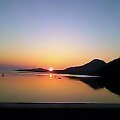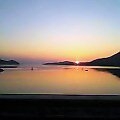故郷のお盆行事
今年も望郷の念にかられ、8月14・15・16と2泊3日で里帰り。私の故郷は日本海の孤島、「隠岐之島」である。過去何回かこのブログでもふれたが、隠岐之島は、本土(島根半島)から約60キロの日本海に浮かぶ孤島で、往時は、日本海の
「風待ち港」として大いに栄えた所であり、江戸から明治にかけては今より遥かに賑わっていた所である。
隠岐之島は大きくは、島前・島後の二つからなり、島前は、
西ノ島・海士島・知夫里島の三つからなる。で、
私の出身は西ノ島である。
西ノ島というのは風光明媚で知られる隠岐之島の中に在っても一際美しい「国賀海岸」を控える、それはそれは美しい島である。人口は約4,500人で16の地区からなり、
小生が生まれ育ったのは戸数60戸程の「大山」と呼ばれる地区である。この大山地区がまた素晴らしい・・。何が素晴らしいか・・?、と言われても一寸困るが一言で云えば、
「何も無いのが素晴らしい」。
そんな素晴らしい大山地区で生涯を過ごした義姉が昨年暮れに他界した。
従って今年は「初盆」、望郷の念もさることながら初盆は帰らなければならない。
そこで、故郷のお盆と初盆行事についてふれてみる事にする。
お盆の行事は宗教行事(仏教)であり、全国そう大きくは違わないと思うが、隠岐では今でも14日・15日の2日間、
お墓の周囲に綱を張り、その綱に旗をつける。旗というのは、七夕の短冊を大きくした感じのもので色紙に切り込みを入れ、
「南無阿弥陀仏」「南無大師遍照金剛」と墨書きしたものである。
この「はた」と呼ばれる短冊を、自分の家の墓は勿論、親戚縁者の墓につけてまわるのである。それも夕方5時過ぎから7時位までの間にまわる。
従って、僅か60戸の小さな地区ではあるが、この2日間の夕方のお墓だけは大変な混雑となる。しかも年に一度の里帰り、
100人が100人顔見知りであり、1・2歩あるいては「今日は・・・」「帰らしゃんしたかの・・・」
等と声を掛け合い挨拶をしなければならない。これはこれで楽しいと云うか大変と云うか・・・故郷ならでは一コマであり、
盆行事の一つとも云える光景である。また、初盆の家には、僅かばかりの御香料を持ってお参りに行く。
そこでまた僅かばかりの時間でも家に上がって挨拶をする、これも中々大変である。僅か60戸の小さな地区で、何と今年初盆の家が6軒、
全体の10%である。如何に高齢化が進んでいるかの証であり、初盆が6軒、出産はゼロ、これもまた大変な事である。
翌16日の朝は、初盆の家は全長1メートル強の帆船(精霊船・
シャーラブネ)を造り、この船に野菜や果物など仏壇に供えてあった物を載せ海に流すのである。
同じ西ノ島町でもこの行事は地区によって違い、大山は初盆の家が個別に船を造って流すが、他の地区の多くは、
小学校高学年から中学生が中心になり、大型の精霊船(藁舟)を造って流す。
これは子供にとっては大変な行事であり、夏休みの約半分はこの船造り作業にとられる。昔は集会場に泊り込みで行い、
そこでは先輩後輩のけじめなど色んな意味での勉強があった様である。この精霊船(藁舟)は大きい船だと20人ほどの大人や子供が乗れる物で、
しかも12時間くらいは海に浮かび続けるものでなければならない。
精霊船に乗って先祖の霊が帰って行くと、お盆行事は一通り終わる。そこで、当日夕方の船に乗り帰阪、
我が家に着いたのは深夜12時をまわっていた。かくして小生の短い夏休みは終ったのである。
15日朝4時45分、大山の家(兄の家)の2階から携帯で撮影、大山湾の日の出前。


15日朝5時00分、大山の家(兄の家)の2階から携帯で撮影、大山湾の日の出。


地区の小中学生が中心になって造る大型の精霊船。帆はお墓にあげるハタでつくられている。

This year, too, I returned to my hometown for three days and two nights in August 14, 15, and 16. My hometown is an isolated island in the Sea of Japan called “Oki Island”. As I have mentioned in this blog several times in the past, Oki-no-shima is an isolated island in the Sea of Japan, about 60 kilometers from the mainland (Shimane Peninsula).
It flourished as a “wind waiting port” and was much more crowded than it is today from the Edo period to the Meiji period.
Oki no Shimae consists of two main islands, Shimamae and Shimago, and the Shimamae is
It consists of three islands: Nishinojima, Amajima and Chiburijima. And.
I am from Nishinojima.
Nishinojima is the most beautiful island in the Oki Islands, which is known for its scenic beauty, with the most beautiful Kuniga Coast. It has a population of about 4,500 and consists of 16 districts.
I was born and raised in an area called “Oyama” with about 60 households. This Oyama area is wonderful again… What’s so great about…? It’s a bit of a puzzle to say, but in a word, it’s
It’s great that there’s nothing there.
My sister-in-law, who spent her entire life in the wonderful Oyama area, passed away at the end of last year.
Therefore, this year is “Hatsu-bon”, and I have to go back to Hatsu-bon, even though it is a feeling of nostalgia.
So, I would like to talk about the Obon and Hatsubon events in my hometown.
The event of Obon is a religious event (Buddhism), and I think it is not so much different in the whole country, but it is still two days of 14th and 15th in Oki.
Put a rope around the grave and attach a flag to the rope. The flag is the one which made Tanabata’s tanzaku large, and put a cut in the colored paper.
It is written in ink, “Nanmu Amida Buddha” and “Nanmu Daishi Itensho Vajra”.
This “hatas”, or short strips of paper, are attached to the graves of relatives, not to mention the graves of one’s own family. It also happens between 5:00 and 7:00 in the evening.
Therefore, even though it is a small area with only 60 houses, the graves are very crowded on the evenings for the past two days. Plus, it’s a once-a-year homecoming.
A hundred people know a hundred people, and one or two steps later, they’re like, “Hey, today…” or “Did you go home…
We should greet each other by saying, “I’m sorry, but I don’t know what to do. This is one of the most enjoyable or difficult moments of my hometown.
It is a scene that can be called one of the Bon events. Also, I go to the house of the Hatsu-bon with a small amount of spices.
So I went up to the house to say hello to them, even if it was only for a short time. In a small district of only 60 houses, there are six houses of the first Bon this year.
It is 10% of the total. It is a proof of how the aging of the population is progressing.
On the morning of the 16th, the house of Hatsubon was a sailing boat (spirit boat) with a length of over a meter.
They would build a ship (sharabneh) and load it with vegetables, fruits and other items that had been offered on the Buddhist altar into the sea.
Even in Nishinoshima-cho, this event differs from district to district.
A large spirit boat (straw boat) is built and floated by mainly upper elementary school students and junior high school students.
This is a big deal for the kids, and they spend about half of their summer vacation working on these boats. We used to stay overnight at the meeting place.
It seems that there was a learning experience in many ways, such as the discipline of seniors and juniors. This spirit boat (straw boat) is a large boat that can accommodate about 20 adults and children.
What’s more, it has to stay afloat for about 12 hours.
When the spirits of the ancestors go back on the spirit boat, the Obon event comes to an end. So, I took the evening boat on the day and went back to Osaka.
It was a little after midnight when we arrived at our house. Thus, my short summer vacation was over.
At 4:45 a.m. on the 15th, I took this photo from the second floor of my brother’s house in Daisen, just before the sunrise on Daisen Bay.









